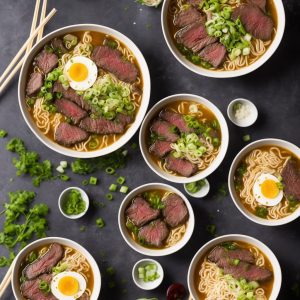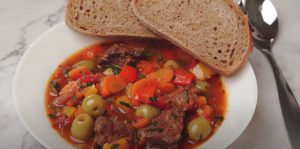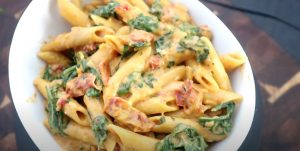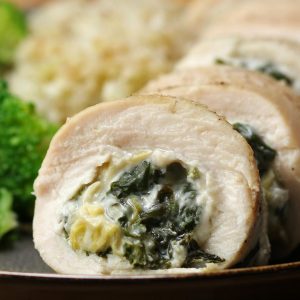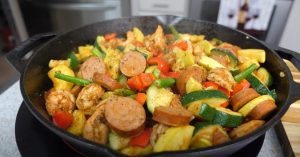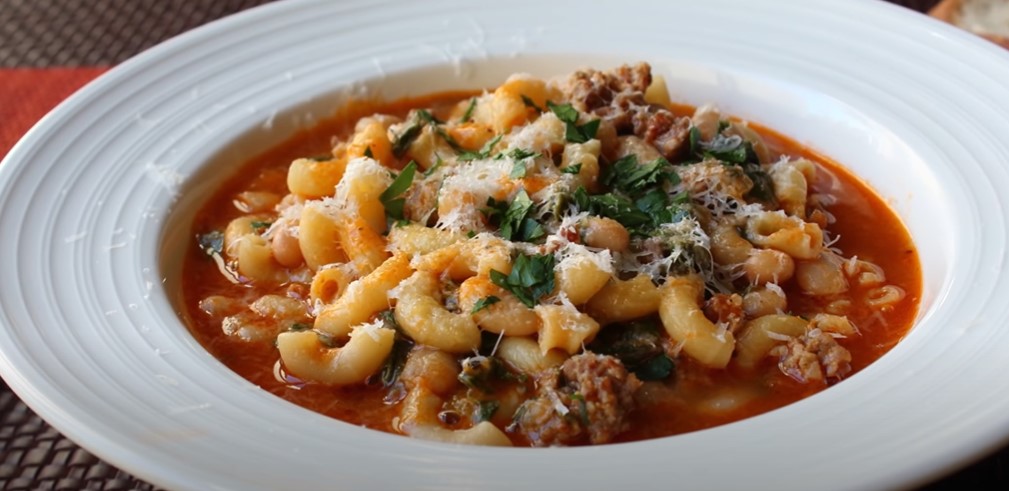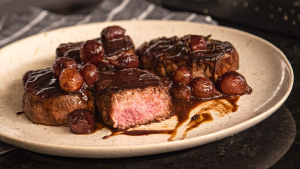Experience the vibrant flavors of Thailand with this quick and easy Thai Basil Beef Bowls recipe. Tender beef, fresh basil, and an array of colorful vegetables come together in a delicious sauce. Serve over jasmine rice for a complete meal that will transport your taste buds to Southeast Asia.
The key ingredients in this recipe are the Thai basil and the sambal oelek. Thai basil is a type of basil native to Southeast Asia that has a unique taste, different from the sweet basil used in Italian cooking. Sambal oelek is a spicy Indonesian chili sauce. Both these ingredients can be found in Asian markets or the international section of larger supermarkets.
Ingredients for the Thai Basil Beef Bowls
Jasmine rice: A fragrant variety of rice that complements the other strong flavors in this dish.
Flank steak: A lean and flavorful cut of beef that works well in stir-fry dishes.
Cornstarch: Used to coat the beef and thicken the sauce.
Vegetable oil: The medium for cooking the ingredients, it also adds a rich note to the dish.
Red bell pepper: Adds a vibrant color and a sweet, mild flavor to the dish.
Yellow onion: Brings depth and sweetness to the stir-fry.
Garlic: Provides a pungent, spicy note that's fundamental in Thai cooking.
Matchstick carrots: They add a crunchy texture and a sweet counterpoint to the spicy flavors.
Fresh basil leaves: Specifically, Thai basil, which has a strong, spicy flavor.
Sesame seeds: They add a nice crunch and a nutty flavor.
Soy sauce: It's the base of the sauce, providing saltiness and umami.
Fish sauce: Another fundamental Thai ingredient, it gives the dish its distinct savory character.
Oyster sauce: Adds a sweet and salty flavor to the sauce.
Brown sugar: Balances the salty and spicy elements in the sauce.
Lime juice: Gives the dish a tangy freshness.
Sambal oelek: This spicy chili sauce adds heat to the dish.
One reader, Cristiano Brice says:





This Thai basil beef bowls recipe is a game-changer! The flavors are incredible and the dish is so easy to make. The combination of tender beef, fresh veggies, and aromatic basil is simply divine. It's become a regular in my meal rotation. Highly recommend trying it out!
Cooking Techniques for Thai Basil Beef Bowls
How to cook rice: Follow the instructions on the package to cook the jasmine rice until it is fluffy and tender.
How to prepare the sauce: Whisk together soy sauce and cornstarch until smooth. Then, stir in water, fish sauce, oyster sauce, brown sugar, lime juice, and sambal oelek if using, and set aside.
How to toss beef: Toss the flank steak with oil and cornstarch to coat it evenly before cooking.
How to sauté vegetables: Sauté the bell pepper, onions, and garlic in a skillet for about 2 to 3 minutes until they are crisp-tender.
How to thicken the sauce: Allow the sauce to simmer for about 1 minute, stirring frequently, until it thickens.
How to wilt basil leaves: Add the basil leaves to the skillet and toss until they have just wilted.
How to garnish: Serve the beef and vegetable mixture over the cooked rice, garnished with small basil leaves and sesame seeds if desired.
How To Make Thai Basil Beef Bowls
Thin slices of beef are cooked with carrots, bell peppers, and basil for these thai beef bowls. The sauce is a savory and spicy concoction with fish sauce.
Serves:
Ingredients
- 1¼cupsjasmine rice,or long grain white rice, for serving
- 1lbflank steak,sliced against the grain into thin strips
- 1tspcornstarch
- 2tbspvegetable oil,(+ 1tsp)
- 1redbell pepper,cored and seeded, diced into 2-inch strips
- ½largeyellow onion,thinly sliced
- 1½tbspgarlic,minced
- 1cupmatchstick carrots
- 1cupfresh basil leaves,roughly chop larger leaves, plus more for garnish
- sesame seeds,optional
For Sauce:
- 3tbsplow-sodium soy sauce
- 1½tspcornstarch
- ⅓cupwater
- 1½tbspfish sauce
- 1tbspoyster sauce
- 2tbspbrown sugar,packed
- 1tbspfresh lime juice
- 1tbspSambal Oelek,or more to taste, optional
Instructions
-
Cook rice according to directions listed on package.
Sauce:
-
In a small mixing bowl whisk together soy sauce and cornstarch until smooth. Stir in water, fish sauce, oyster sauce, brown sugar, lime juice and Sambal Oelek if using, set aside.
Beef:
-
Toss beef with oil and cornstarch. Heat 2 tablespoons oil in a large skillet or wok over moderately high heat.
-
Add beef and cook until browned on both sides but still slightly under-cooked in the center. Transfer beef to a plate while leaving oil in skillet.
Veggies:
-
Reduce heat slightly, add bell pepper, onions and garlic and saute for about 2 to 3 minutes until crisp tender. Add carrots and whisk sauce mixture once more then pour into skillet.
-
Allow sauce to simmer for about 1 minute, stirring frequently, until thickened. Return beef to skillet along with basil leaves, and toss until basil has just wilted.
-
Serve immediately over cooked rice garnished with small basil leaves and sesame seeds if desired.
Nutrition
- Calories: 531.06kcal
- Fat: 17.07g
- Saturated Fat: 4.50g
- Trans Fat: 0.05g
- Monounsaturated Fat: 9.01g
- Polyunsaturated Fat: 1.79g
- Carbohydrates: 61.63g
- Fiber: 2.86g
- Sugar: 8.44g
- Protein: 30.77g
- Cholesterol: 77.11mg
- Sodium: 1151.22mg
- Calcium: 92.27mg
- Potassium: 732.84mg
- Iron: 5.01mg
- Vitamin A: 330.21µg
- Vitamin C: 45.89mg
Pro Tip for Perfecting Thai Basil Beef Bowls
When cooking the flank steak, it's important to not overcook it. Overcooking can result in a tough and chewy texture. Instead, aim for a medium-rare to medium doneness. This will ensure the steak remains juicy and tender. Also, remember to let the steak rest for a few minutes after cooking before slicing. This allows the juices to redistribute throughout the steak, enhancing its flavor.
Time-Saving Tips for Making Thai Basil Beef Bowls
Prep ahead: Chop vegetables and marinate the beef the night before to save time on the day of cooking.
One-pot cooking: Consider using a large skillet or wok to cook the entire dish in one pot, reducing the number of dishes to clean.
Organized workspace: Before starting, ensure all ingredients and cooking utensils are within reach to streamline the cooking process.
Quick-cooking rice: Use a rice cooker or instant pot to cook the jasmine rice quickly while you prepare the rest of the dish.
Multi-task: While the rice is cooking, prep the vegetables and mix the sauce to maximize efficiency in the kitchen.
Substitute Ingredients For Thai Basil Beef Bowls Recipe
jasmine rice - Substitute with long grain white rice: Long grain white rice has a similar texture and flavor profile to jasmine rice, making it a suitable substitute for this recipe.
flank steak - Substitute with skirt steak: Skirt steak has a similar texture and flavor to flank steak, and it works well in stir-fry dishes like this one.
cornstarch - Substitute with arrowroot powder: Arrowroot powder can be used as a thickening agent in place of cornstarch and is a suitable substitute in this recipe.
vegetable oil - Substitute with canola oil: Canola oil has a neutral flavor and a high smoke point, making it a good substitute for vegetable oil in this recipe.
red bell pepper - Substitute with orange bell pepper: Orange bell peppers have a similar sweetness and crunch to red bell peppers, making them a suitable substitute in this recipe.
yellow onion - Substitute with white onion: White onions have a similar flavor profile to yellow onions and can be used as a substitute in this recipe.
garlic - Substitute with garlic powder: Garlic powder can be used as a substitute for fresh garlic in this recipe, providing a similar flavor without the need for mincing.
matchstick carrots - Substitute with julienned carrots: Julienned carrots can be used as a substitute for matchstick carrots, providing the same shape and texture in the dish.
fresh basil leaves - Substitute with cilantro leaves: Cilantro leaves can provide a fresh and aromatic flavor similar to Thai basil and can be used as a substitute in this recipe.
sesame seeds - Substitute with chopped peanuts: Chopped peanuts can add a similar nutty crunch to the dish, making them a suitable substitute for sesame seeds.
low-sodium soy sauce - Substitute with tamari: Tamari is a gluten-free alternative to soy sauce and can be used as a substitute in this recipe.
fish sauce - Substitute with soy sauce: Soy sauce can provide a similar umami flavor to fish sauce and can be used as a substitute in this recipe.
oyster sauce - Substitute with hoisin sauce: Hoisin sauce has a similar sweet and savory flavor to oyster sauce and can be used as a substitute in this recipe.
brown sugar - Substitute with coconut sugar: Coconut sugar can be used as a substitute for brown sugar, providing a similar sweetness to the dish.
fresh lime juice - Substitute with rice vinegar: Rice vinegar can provide a tangy acidity similar to fresh lime juice and can be used as a substitute in this recipe.
sambal oelek - Substitute with sriracha: Sriracha can provide a similar level of heat and flavor to sambal oelek and can be used as a substitute in this recipe.
Plating Ideas for Thai Basil Beef Bowls
Elevate the plating: Arrange the jasmine rice in a neat mound at the center of the bowl, ensuring it is evenly distributed. This will serve as the base for the other ingredients.
Artful beef placement: Thinly slice the flank steak against the grain and fan it out over the rice, creating an elegant and visually appealing arrangement.
Vibrant vegetable placement: Carefully position the sautéed bell peppers, onions, and carrots around the flank steak, adding pops of color and texture to the dish.
Garnish with basil leaves: Place fresh basil leaves strategically around the bowl, adding a touch of brightness and freshness to the overall presentation.
Sprinkle with sesame seeds: Lightly sprinkle sesame seeds over the dish, ensuring they are evenly distributed for a subtle crunch and visual appeal.
Sauce drizzle: Drizzle the flavorful sauce over the beef and vegetables, using a steady hand to create an attractive pattern on the plate.
Final inspection: Take a moment to ensure that each element is meticulously placed, creating a visually stunning and appetizing presentation for the esteemed judges.
Essential Kitchen Tools for Making Thai Basil Beef Bowls
Cutting board: A flat surface used for cutting and preparing ingredients.
Chef's knife: A versatile kitchen knife used for slicing, dicing, and chopping various ingredients.
Skillet: A frying pan with a flat bottom and sloping sides, used for sautéing and frying.
Small mixing bowl: A bowl used for combining and mixing smaller quantities of ingredients.
Large skillet or wok: A wide, flat-bottomed pan with sloping sides, used for stir-frying and cooking larger quantities of food.
Whisk: A kitchen utensil used for blending ingredients together and incorporating air into mixtures.
Spatula: A flat, flexible utensil used for flipping and turning food while cooking.
Measuring cups and spoons: Tools used for accurately measuring ingredients in cooking and baking.
Small mixing bowl: A bowl used for combining and mixing smaller quantities of ingredients.
Saucepan: A deep cooking pan with a long handle and a lid, used for making sauces and heating liquids.
Storage and Freezing Instructions for Thai Basil Beef Bowls
- To store leftover thai basil beef bowls, allow the dish to cool completely to room temperature before transferring it to an airtight container. Store the beef, vegetables, and sauce separately from the rice to prevent the rice from becoming soggy.
- When stored properly in the refrigerator, the thai basil beef and vegetables will last for up to 3-4 days, while the rice can be kept for up to 5 days.
- To reheat, place the desired portion of beef, vegetables, and sauce in a microwave-safe dish and heat until warmed through. Reheat the rice separately, adding a splash of water if needed to restore moisture.
- If you want to freeze the thai basil beef bowls for later consumption, it's best to freeze the components separately:
- Allow the beef and vegetable mixture to cool completely before placing it in a freezer-safe container or resealable bag. Remove as much air as possible to prevent freezer burn.
- Store the sauce in a separate freezer-safe container or resealable bag.
- Freeze the rice in a freezer-safe container or resealable bag, ensuring that it's tightly sealed to maintain freshness.
- When properly frozen, the thai basil beef and sauce can be stored for up to 2-3 months, while the rice can be kept frozen for up to 6 months.
- To reheat from frozen, thaw the beef, vegetables, sauce, and rice in the refrigerator overnight. Reheat the components separately in the microwave or on the stovetop until heated through, then combine and serve.
How To Reheat Thai Basil Beef Bowl Leftovers
- Reheat the rice separately in the microwave or on the stovetop with a splash of water to prevent it from drying out. Fluff the rice with a fork before serving.
- For the beef and vegetables, reheat them together in a skillet or wok over medium-high heat. Add a tablespoon of water or beef broth to help steam the ingredients and prevent them from sticking to the pan.
- Stir-fry the beef and vegetables for 2-3 minutes, or until heated through. Be careful not to overcook the beef, as it may become tough.
- If the sauce has thickened too much during storage, add a splash of water or chicken broth to thin it out while reheating.
- Alternatively, you can reheat the beef and vegetables in the microwave. Place them in a microwave-safe dish, cover with a damp paper towel, and heat in 30-second intervals, stirring between each interval, until heated through.
- Once the rice, beef, and vegetables are heated, assemble the bowls by placing the rice at the bottom and topping it with the beef and vegetable mixture.
- Garnish with fresh basil leaves and a sprinkle of sesame seeds for added flavor and texture.
- If desired, you can also add a squeeze of fresh lime juice or a drizzle of sriracha sauce to brighten up the flavors and add a kick of heat.
Interesting Trivia About Thai Basil Beef Bowls
The Thai basil beef bowls recipe is a delicious and flavorful dish that combines the aromatic flavors of basil with tender beef and a savory sauce. This dish is a popular street food in Thailand and is often served with jasmine rice. The combination of fresh basil, tender beef, and a savory sauce creates a perfect balance of flavors and textures. It's a great way to enjoy a taste of Thai cuisine at home.
Is Making Thai Basil Beef Bowls at Home Cost-Effective?
This Thai Basil Beef Bowls recipe is quite cost-effective for a household. The use of affordable ingredients like flank steak, bell peppers, onions, and carrots makes it a budget-friendly option. The dish offers a delightful blend of flavors and textures, making it a satisfying meal for the entire family. The approximate cost for a household of 4 people is around $20-$25, making it an economical choice for a flavorful and nutritious dinner. I would rate this recipe a solid 8 out of 10 for its affordability, taste, and overall appeal.
Is This Thai Dish Healthy or Not So Much?
The Thai basil beef bowl recipe is a relatively healthy dish, offering a balance of protein, vegetables, and complex carbohydrates. The use of lean flank steak provides a good source of protein, while the inclusion of bell peppers, onions, carrots, and basil adds essential vitamins and minerals. Jasmine rice serves as a complex carbohydrate, providing energy and fiber.
However, there are a few aspects of the recipe that could be improved to make it even healthier:
- Reduce the amount of oil used in cooking the beef and vegetables to lower the overall fat content
- Opt for low-sodium soy sauce and fish sauce to decrease the dish's salt content
- Use a leaner cut of beef, such as sirloin or tenderloin, to further reduce fat intake
- Increase the proportion of vegetables to beef, ensuring a higher intake of fiber and nutrients
- Consider using brown jasmine rice instead of white for added fiber and nutrients
- Limit the amount of added sugar in the sauce or replace it with a natural sweetener like honey
By incorporating these changes, you can enhance the nutritional value of the Thai basil beef bowl while still maintaining its delicious flavor profile. Additionally, you could experiment with adding other nutrient-dense vegetables like broccoli, snap peas, or mushrooms to boost the dish's overall health benefits. Serving the beef and vegetables over a bed of leafy greens, such as spinach or kale, can also increase the meal's fiber and vitamin content, making it an even more well-rounded and nutritious option.
Editor's Opinion on Thai Basil Beef Bowls
The Thai basil beef bowls recipe is a delightful combination of flavors and textures. The tender flank steak is perfectly complemented by the vibrant bell peppers, onions, and carrots, while the aromatic basil leaves add a refreshing touch. The sauce, with its balance of sweet, savory, and tangy flavors, ties everything together beautifully. This dish is a wonderful balance of savory and aromatic flavors, and the jasmine rice provides a perfect base for the delicious beef and vegetables. It's a delightful and satisfying meal that is sure to impress anyone who tries it.
Enhance Your Thai Basil Beef Bowls Recipe with These Unique Side Dishes:
Similar Recipes to Try If You Love Thai Basil Beef Bowls
Appetizer and Dessert Pairings for Thai Basil Beef Bowls
Why trust this Thai Basil Beef Bowls Recipe:
This recipe offers a tantalizing fusion of flavors and textures, ensuring a delightful dining experience. The succulent flank steak is expertly seasoned and cooked to perfection, while the vibrant bell pepper and onion add a delightful crunch. The aromatic basil leaves infuse the dish with a fragrant freshness, complementing the savory sauce that boasts a harmonious blend of soy sauce, fish sauce, and oyster sauce. With the addition of matchstick carrots and a hint of lime juice, this recipe promises a symphony of Thai flavors that will undoubtedly captivate your taste buds.
Was this page helpful?
Have your own special recipe to share? Submit Your Recipe Today!





